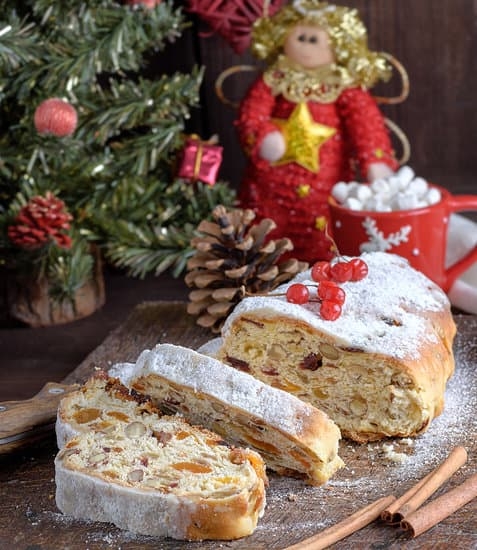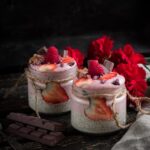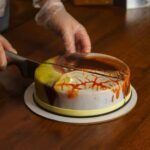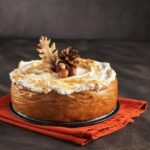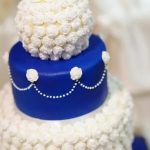Whipped cream frosting for decorating cakes is a versatile and delicious option that has been a favorite among bakers and cake decorators for generations. This light and airy frosting, made by whipping heavy cream and sugar until stiff peaks form, offers a delicate sweetness that complements a wide variety of cake flavors. Its smooth texture makes it perfect for creating intricate designs and decorations on cakes, cupcakes, and other baked goodies.
Whipped cream frosting is a popular choice for decorating cakes due to its lightness and subtle flavor profile, which allows the natural taste of the cake to shine through without overwhelming it. Unlike buttercream or fondant frostings, whipped cream frosting provides a refreshing alternative that is perfect for those who prefer a less sweet dessert option. Additionally, its fluffy consistency makes it easy to work with when piping intricate designs or creating smooth finishes on cakes.
Whether you’re looking to add a touch of elegance to a classic vanilla cake or experimenting with unique flavor combinations on specialty desserts, whipped cream frosting offers endless possibilities for creativity in cake decoration.
In this article, we will explore the history of whipped cream frosting, its benefits over other types of frosting, tips for making the perfect batch every time, various flavored variations to try out, techniques for achieving stunning cake designs, troubleshooting common issues faced when working with whipped cream frosting, and some inspiring recipe ideas to elevate your cake decorating game.
History of Whipped Cream Frosting
Whipped cream frosting has a long and rich history that dates back centuries. The origins of whipped cream can be traced to Europe, where it was initially prepared by hand using a whisk or wooden spoon.
This labor-intensive process involved beating heavy cream until it reached a light and fluffy consistency, perfect for adorning cakes and desserts. Over time, advancements in kitchen appliances such as the electric mixer have made the task of whipping cream much easier and more efficient.
One of the earliest recorded mentions of whipped cream frosting can be found in French culinary history during the 17th century. French chefs were known for their meticulous attention to detail and penchant for creating delicate pastries and desserts. Whipped cream became a staple in French patisseries, adding a touch of elegance and indulgence to various sweet treats. The popularity of whipped cream frosting soon spread across Europe and eventually made its way to other parts of the world.
In the United States, whipped cream frosting gained widespread popularity in the mid-20th century as home baking became more common. With its light texture and subtle sweetness, whipped cream frosting quickly became a favorite choice for decorating cakes for special occasions such as birthdays, weddings, and holidays. Today, whipped cream frosting remains a beloved option for both professional bakers and home cooks alike, thanks to its versatility and ability to complement a wide variety of cake flavors.
Benefits of Using Whipped Cream Frosting
Whipped cream frosting is a versatile and popular choice for decorating cakes due to its light and fluffy texture, delicate flavor, and elegant appearance. Unlike buttercream or fondant, whipped cream frosting provides a refreshing burst of sweetness without being overly heavy or overly sweet.
This makes it ideal for those who prefer a lighter option when it comes to cake decoration. The whipped cream frosting is also known for its ability to complement a wide variety of cake flavors, making it suitable for almost any type of cake.
Healthier Option
One of the main benefits of using whipped cream frosting over other types of frosting is that it is generally considered a healthier option. Whipped cream frosting is typically made with simple ingredients such as heavy cream, sugar, and vanilla extract, which means it contains less artificial additives and preservatives compared to other frostings. Additionally, whipped cream frosting has a lower fat content than buttercream, making it a lighter alternative for those who are watching their calorie intake.
Natural Ingredients
Another advantage of using whipped cream frosting is that it can be easily customized with natural flavor extracts, fresh fruit purees, or melted chocolate to create unique and delicious variations. The use of natural ingredients not only enhances the taste but also ensures that the frosting is free from artificial flavors or colors. This makes whipped cream frosting an attractive option for those who prefer more wholesome and organic options when decorating cakes.
Tips for Making Perfect Whipped Cream Frosting
When it comes to decorating cakes, using whipped cream frosting can be a game-changer. Whipped cream frosting is a light and airy topping that adds a subtle sweetness and creamy texture to any cake.
What sets whipped cream frosting apart from other types of frostings is its versatility – it can be easily flavored, colored, and piped into intricate designs. This makes it a favorite choice among bakers, especially for those looking to create visually stunning cakes that taste as good as they look.
One of the key benefits of using whipped cream frosting for decorating cakes is its ability to complement the flavors of the cake without overpowering them. Traditional buttercream or fondant frostings can sometimes be too sweet or heavy, taking away from the cake itself.
Whipped cream frosting, on the other hand, allows the flavors of the cake to shine through while still providing a delicious and decorative touch. Additionally, whipped cream frosting is known for its light and fluffy consistency, making it easy to work with when piping borders, flowers, or other intricate designs on cakes.
Furthermore, unlike buttercream frosting which often requires complex techniques to achieve the desired consistency, whipped cream frosting can be made with just a few simple ingredients. By combining heavy whipping cream, powdered sugar, and vanilla extract, you can whip up a batch of delicious whipped cream frosting in no time.
The key is to ensure that your mixing bowl and whisk are cold before starting to whip the cream to stiff peaks. This will help stabilize the frosting and prevent it from becoming runny or deflating over time.
| Benefits of Whipped Cream Frosting | Key Points |
|---|---|
| Complements cake flavors | Allows flavors of the cake to shine through |
| Light and airy consistency | Ideal for piping intricate designs on cakes |
| Simple ingredients | Only requires heavy whipping cream, powdered sugar, and vanilla extract |
Flavored Variations of Whipped Cream Frosting
Whipped cream frosting is a versatile and delicious option for decorating cakes, offering a light and fluffy texture that pairs well with a variety of cake flavors. One of the benefits of using whipped cream frosting is its ability to be easily customized with different flavors to suit specific preferences or themes for special occasions. Here are some ideas for flavored variations of whipped cream frosting that can elevate your cake decorating game:
- Classic Vanilla: Add a touch of vanilla extract or vanilla bean paste to the whipped cream frosting for a simple yet delicious flavor profile that complements most cakes.
- Chocolate Lovers: Mix in cocoa powder or melted chocolate to create a rich and decadent chocolate whipped cream frosting that is perfect for chocolate cake lovers.
- Fruity Delights: Incorporate fruit purees such as strawberry, raspberry, or mango into the whipped cream frosting for a burst of fruity freshness that adds color and flavor to your cakes.
These flavored variations can be adjusted based on personal taste preferences and the type of cake being decorated. For example, adding coffee extract to whipped cream frosting can create a mocha flavor that goes well with espresso-flavored cakes, while peppermint extract can be used for a refreshing twist on chocolate cakes. Experimenting with different flavor combinations is all part of the fun when working with whipped cream frosting for cake decoration.
The Key Benefits of Using Flavored Variations
- Customize according to preferences
- Add unique twists
- Enhances the overall cake experience
Overall, exploring different flavored variations of whipped cream frosting allows for endless creativity and possibilities when it comes to decorating cakes. Whether you’re looking to create a classic dessert with vanilla notes or want to surprise your guests with an unexpected flavor combination, incorporating different flavors into your whipped cream frosting can take your cake decorating skills to the next level.
Techniques for Decorating Cakes With Whipped Cream Frosting
Whipped cream frosting is a versatile and popular choice for decorating cakes due to its light and fluffy texture, along with its delicious flavor. When it comes to techniques for decorating cakes with whipped cream frosting, there are various methods and tools that can be used to create stunning cake designs. Whether you are a beginner or a seasoned baker, incorporating these techniques can elevate the presentation of your cakes and make them truly stand out.
Piping Techniques
One of the most common ways to decorate cakes with whipped cream frosting is through piping. Using different tips and nozzles, bakers can create intricate designs such as rosettes, swirls, stars, and even borders on cakes. By adjusting the pressure on the piping bag and practicing different movements, you can achieve beautiful patterns that will impress your guests. Piping also allows for precision when adding details or writing messages on cakes.
Layering and Stacking
Another technique for decorating cakes with whipped cream frosting is layering and stacking. This involves building multiple layers of cake with whipped cream frosting in between each one. By spreading a consistent layer of frosting on each cake layer before stacking them, you can create a visually appealing dessert that showcases both the cake and the frosting. This technique works particularly well for creating tall or tiered cakes that are perfect for special occasions like weddings or birthdays.
Using Stencils and Templates
For those looking to add more intricate designs to their cakes, using stencils and templates with whipped cream frosting can be a game-changer. By placing a stencil or template on top of the cake and gently dabbing whipped cream frosting over it, you can transfer elegant patterns onto the surface of the cake.
This technique is great for adding decorative elements like flowers, lace patterns, or even personalized images to your cakes. Experimenting with different stencil designs can help you find unique ways to decorate your creations with whipped cream frosting.
Troubleshooting Common Issues With Whipped Cream Frosting
When it comes to using whipped cream frosting for decorating cakes, there can be a few common issues that may arise during the process. It is important to address these problems promptly to ensure that your cake turns out perfectly. Below are some common problems with whipped cream frosting and how to troubleshoot them:
- Overbeating: One common issue when making whipped cream frosting is overbeating the mixture, which can result in a grainy and curdled consistency. To fix this problem, stop beating the cream immediately once it reaches stiff peaks. If you have already overbeaten the cream, you can try adding a little bit of fresh cream and gently folding it in to smooth out the texture.
- Melting Whipped Cream: Whipped cream frosting can sometimes become too soft or start melting if it is exposed to warm temperatures or if the cake itself is warm. To prevent this issue, make sure to chill your mixing bowl and beaters before whipping the cream. Additionally, refrigerate the cake after frosting it to help maintain the stability of the whipped cream.
- Lack of Stability: Whipped cream frosting may not hold its shape well, especially if it is being used to create intricate decorations on a cake. To improve stability, consider adding a stabilizer like gelatin or cornstarch to the whipped cream mixture. This will help keep the frosting firm enough to hold its shape without collapsing.
By addressing these common issues and following these troubleshooting tips, you can ensure that your whipped cream frosting turns out smooth, stable, and perfect for decorating cakes. With a little practice and patience, you’ll be able to master the art of using whipped cream frosting to create beautiful and delicious cakes for any occasion.
Whipped Cream Frosting Recipe Ideas
Whipped cream frosting is not just a simple topping for cakes; it has become an essential element in cake decorating, bringing a light and airy touch to any sweet creation. Whether you are looking to add a delicate finish to a classic birthday cake or create an elaborate design for a special occasion, whipped cream frosting offers endless possibilities for creativity.
By exploring unique and creative recipes, you can elevate your cake decorations to new heights and impress your guests with both flavor and presentation.
One delightful recipe idea is incorporating fresh fruit into your whipped cream frosting for a burst of color and natural sweetness. From juicy berries like strawberries and blueberries to tropical fruits like mangoes and kiwis, the addition of fresh fruits not only enhances the visual appeal of your cake but also adds a refreshing taste that complements the lightness of the whipped cream.
This innovative twist on traditional whipped cream frosting will surely tantalize your taste buds and leave a lasting impression on those indulging in your delectable creation.
For those craving a rich and decadent experience, consider infusing your whipped cream frosting with gourmet flavors such as espresso, caramel, or even liqueurs like Baileys or Grand Marnier. These sophisticated additions bring depth and complexity to the delicate sweetness of the whipped cream, creating a luxurious treat fit for special occasions such as anniversaries, weddings, or milestone celebrations.
By experimenting with different flavor profiles, you can customize your whipped cream frosting to suit the theme and mood of any event, ensuring that every slice of cake is not only visually stunning but also irresistibly delicious. So go ahead, unleash your culinary imagination, and let whipped cream frosting be your canvas for creating edible works of art that will leave everyone craving more.
Frequently Asked Questions
Can You Use Whipped Cream Frosting to Decorate a Cake?
Whipped cream frosting can be used to decorate a cake, but it may not hold intricate designs as well as buttercream or fondant. It is best for simple decorations and a light, airy texture on cakes.
How Do You Stiffen Whipped Cream for Piping?
To stiffen whipped cream for piping, it is essential to ensure that the heavy cream used is cold. Adding powdered sugar or stabilizers like gelatin or cornstarch can also help retain the whipped cream’s shape and structure for piping.
What Is the Best Frosting for Decorating Cakes?
The best frosting for decorating cakes depends on personal preference and the desired outcome. Buttercream frosting is popular for its versatility, easy application, and ability to hold intricate designs. Fondant offers a smooth finish and allows for elaborate decorations.
Royal icing is great for detailed designs and creating a glossy finish on cakes. Ultimately, the best frosting choice will depend on the specific requirements of the decoration and taste preferences of the individual.

Welcome to our cake decorating blog! My name is Destiny Flores, and I am the proud owner of a cake decorating business named Cake Karma. Our mission is to provide delicious, beautiful cakes for all occasions. We specialize in creating custom cakes that are tailored specifically to each customer’s individual needs and tastes.

